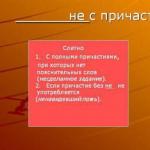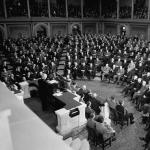Who checks the exam papers, what to do if the form is damaged, how to appeal and whether it is possible to get answers in advance
Coordinates public observers
Who checks the exam papers
A computer.Forms of the test part are processed using a computer: the specialists of the information processing center scan the works, then the program checks the answers from the form with the correct answers. To avoid automatic checking errors, write legibly and with black pen only. If you suspect that you have lost a point for a technical reason, for example, due to a vaguely marked answer, it is better to appeal.
USE experts.Tasks with a detailed answer are checked by the subject commission of teachers of the region. Each work is checked at once by two expert teachers. If the assessors' assessments differ significantly, the work is transferred to a third expert.If the discrepancy in points is small, then the arithmetic mean of the assessments of the two experts will be rounded up.
What to do if the USE form is damaged
Contact the organizer.If you messed up the form before starting the exam, the organizer will replace it along with the set of assignments. If you spoil the form when you have already started completing the assignments, you will have to hand it over to the organizer and come to the exam on a reserve day. Keep in mind that mistakes in answers are not a reason to change forms.
Write your answer in the reserved field.Most often, graduates make mistakes when filling out short answers. If you gave an incorrect answer and noticed an error, use the special field at the bottom of the page. In the field for corrections, you need to enter the task number and the correct answer.
Learn to fill out the form correctly... To avoid annoying blots, mistakes and not waste time on formalities, practice at home. Open demo versions of KIMs for your subjects on the FIPI website. Carefully read and memorize the rules for filling out the forms: how to fill out this or that task, which punctuation marks to enter with spaces, and which ones without, which characters to put in one cell, and which ones between the cells.
When is it worth filing an appeal
The appeal is filed in two cases:
- The procedure for holding the Unified State Exam has been violated.If outside noise or the actions of other participants in the classroom interfered with the exam, report it right away. In case of a violation of the order of the exam, file an appeal before leaving the TET.
- Disagree with the exam result.Disagreement with the points awarded is to be appealed within two working days after the official announcement of the results. In this case, you write an application addressed to the head of the organization that admitted you to the exam (school, department of education). The manager must submit the application to the conflict committee, which will consider your work.

How to file an appeal for the exam
Results of the appeal. The appeal may be dismissed. If the appeal is not satisfied, you will remain with your points, you will not be allowed to rewrite the work. If your appeal is upheld, your work will be re-checked, and as a result, your scores may be raised or lowered.
Is it possible to get the USE answers somewhere in advance
You won't be able to get the 2018 KIMs.In previous years, there was a theoretical opportunity to open the CMMs in Vladivostok, solve them and send the answers to Moscow by the time the exam began. This year there is no way left to get the CMMs. The fact is that all forms are brought to the examination sites in encrypted form on disks. Paper CMMs are no longer used, it is no longer possible to pay someone and decide options in advance.
The registration form and CMMs will now be printed on a printer right during the exam in front of the children. Be sure: if someone offers to buy the USE answers, they are scammers. Don't pay anyone any money, believe in yourself and your knowledge.
Are you curious to know who these mysterious experts who test the exam are and how they work? So, now you can find out about it first-hand. Because for the seventh year I have been one of these experts.
It is called very long and solidly: "expert of the subject commission for the state final certification of educational programs of secondary general education."
Since I work as an assistant professor at the Department of Information Technology, it is logical that I am an expert in computer science and ICT (information computer technology). But experts in other subjects work the same way.
Let me remind you that the USE assignments are divided into three parts: A, B and C. Part "A" is also called a "guessing game", because here the student must choose one of several answers offered to him. Part "A" is now missing in the math and literature assignments. In part "B" you need to write a short answer. For tasks of type "C" the guys give detailed free answers.
Answers to tasks "A" and "B" are checked by computers. But the tasks of part "C" are evaluated by experts, that is, people. Each work is checked independently by two experts. If their marks for the same answer to any task differ by one point, then a higher mark is finally given. That is, the discrepancy in the assessments of the experts is interpreted in favor of the student.

If the discrepancy is more than one point, then the work is transferred to a third expert. His assessment is final. The fewer such “third checks” the commission has, the more professional it is. Because this suggests that all experts have carefully studied the criteria for evaluating the work and put the points in the same way. If the discrepancy is more than 15%, then the team of experts can be disbanded and a new one recruited.
The subject commission is formed from the most experienced school teachers who teach this subject, and 20-25 percent - from university teachers. In particular, the subject commission on computer science and ICT of the Ivanovo region, which I am a member of, has 20 people, five of them are high school teachers.
Some time before the exam, experts undergo training and certification. In the first years of the USE, the study consisted of the following: we met several times, considered the proposed tasks and tasks of previous years, looked for solutions, discussed the solutions proposed by the authors of the assignments, agreed on points of view.
In recent years, preparation for the audit has been moved online. First, we are sent teaching materials that represent real answers from students, assessment criteria and detailed explanations of possible difficult situations. We study these answers, evaluate them and can check ourselves whether we are doing it correctly. Then we pass a test, during which each expert must evaluate twenty answers to tasks of types C1, C2, C3, C4 in a limited time. If the test is passed well, that is, the expert confirms his qualifications, then he is issued with the following certificate:

On the day of the exam, all the work of graduates from all EETs of the region are sent to a single center, where the answers to the tasks of part "C" are scanned, encrypted and randomly distributed by the names of the experts. The next day we come to a specially designated building, we are given options for assignments, assessment criteria and printed out specifically for each scanned answers, which we must evaluate. I emphasize that the expert does not see any information about the students, only the decisions themselves.
This year, the check was carried out in rooms equipped with video and audio surveillance systems. It was impossible to take ANYTHING with you to the classroom and take it out of the classroom. Moreover, we were even asked to turn off the mobile phones left in the locked room, where we undressed and where we left all our belongings. That is, we carried out the test in almost the same conditions in which the students wrote the exam. True, at the entrance to the building, we did not pass through the frames of metal detectors and could leave the auditorium without an attendant.

The problem of objectivity of results can be considered in two aspects. The first aspect is the objectivity of the points awarded, the second is the degree to which the level of knowledge and skills of students is reflected in the USE results. With the accumulation of experience in conducting a unified state exam, doubts among parents and students about the objectivity of the points awarded are becoming less and less. This is due, among other things, to the great work that the Education Committee, teachers and school administrations are doing to explain the procedure for holding the Unified State Exam to students and their parents. The organizational, technological and informational and analytical support of the Unified State Exam in St. Petersburg is carried out by the Regional Center for Assessment of the Quality of Education and Information Technologies of St. Petersburg (RCOKOiIT). The USE support website (ege.spb.ru) created by the RTSOKOiIT contains all the information necessary for students and their parents. The openness of the USE procedure is increasing. In St. Petersburg, graduates can see their scores on the specified website, and from this year - and electronic images of their work. The most important information is also published on stands in educational institutions and on school websites. Students' examination papers can be divided into two parts:
- checking the tasks of parts A (tasks with a choice of answer) and B (tasks with a free answer), which is carried out by the method of computer processing;
- verification of part C by experts.




